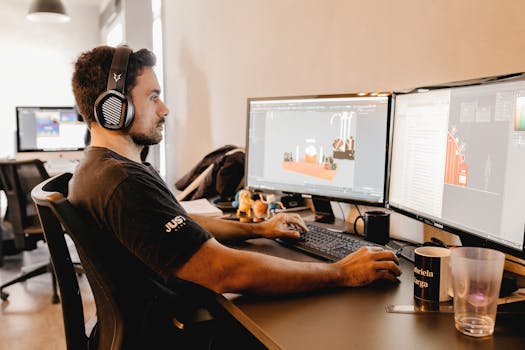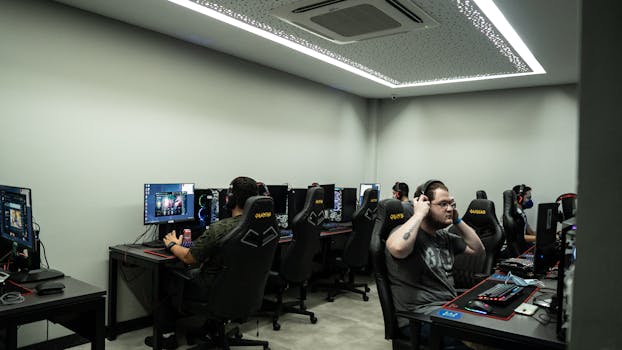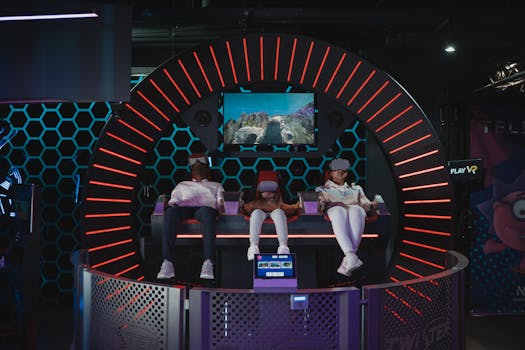Tips
Top 10 Virtual Reality Games for Sports Enthusiasts
Discover the top 10 virtual reality games for sports enthusiasts. Dive into realistic VR action, boost coordination, and challenge friends with expert strategies and immersive gameplay tips.
Anuncios
Stepping into a digital arena feels a lot like walking onto a real playing field: your senses sharpen, adrenaline rises, and every move counts. For sports fans, the best virtual reality games deliver this rush, blending skill with fun in new, realistic ways.
These days, sports lovers look to virtual worlds for more than couch-side action. Virtual reality games bring friendly competition, skill development, and the thrill of athletic achievement into anyone’s reach, regardless of location or weather.
If you crave immersive, active experiences that challenge your reflexes and tactics, exploring this lineup of the top 10 virtual reality games for sports enthusiasts could change your leisure time forever. Let’s get started and see how you can elevate your gameplay.
Experience Full-Body Action with Realistic VR Sports Titles
Jump into these virtual reality games and you’ll notice an immediate demand for movement—no passive participation here. Sweat, stretch, and strategy all come into play when your entire body is in the game.
For example, when you play a realistic tennis sim, the controller becomes your racket. Swing hard for a backhand, reach for a lob, or dart across your living room like you’re chasing match point at Wimbledon.
Dialing in Movement Precision
Unlike flat-screen titles, virtual reality games reward smooth, precise motion. These systems read the angle, speed, and timing as you serve in VR tennis, so a late swing pushes the ball wide every time.
Players who mimic real-life stances improve much faster. Stand with feet at shoulder width, grip the controller like a real bat or paddle, and move from your hips to get realistic power.
Practice this in the living room and you’ll hear yourself say, “I feel like I’m really in the match.” Repeating those cues builds authentic muscle memory with every round.
Learning Rules by Playing
Virtual reality games teach rules through interactive gameplay. In VR basketball, you’ll shoot free throws by copying realistic form, press buttons to dribble, and dodge AI defenders by physically swinging left or right on the court.
Most VR sports titles introduce tutorials that show exactly what to do, so new players can catch up without flipping through rulebooks. Just follow the on-screen prompts for a smooth start.
This practical, hands-on guidance means you learn what’s allowed and what isn’t while having fun. Bring these insights into live games or social tournaments with friends.
| VR Sports Game | Main Activity | Unique Feature | Try This Next |
|---|---|---|---|
| VR Tennis Ace | Tennis | Full-body motion tracking | Practice serving in the training court |
| Paddle Clash VR | Table Tennis | Ball spin physics | Challenge AI rivals in tournament mode |
| Hoops Arena | Basketball | True-to-life scoring system | Join a multiplayer pickup game |
| Boxing Blitz VR | Boxing | Stamina-based stamina drains | Train combos against the heavy bag |
| VR Golf Master | Golf | Controller as golf club | Perfect your swing in practice rounds |
Push Your Competitive Edge with Multiplayer Challenges
The fastest way to improve is to go head-to-head with other players in real time. Virtual reality games offer online matchmaking that pairs you with athletes worldwide, raising the bar and the fun factor.
When the stakes go up, your reaction time, decision-making, and sportsmanship sharpen. Clutch wins and narrow losses alike make every match memorable, building your skill and confidence as you play.
Building Team Coordination
Cooperating with strangers can be tough without facial cues. Use simple phrases like, “I’ll cover left!” or “Switch on defense!” in team-based VR games for smoother, winning plays.
Mirroring real sports, supportive talk and clear instructions keep virtual teams organized. Prepare short, go-to phrases before you jump into multiplayer—practice them with friends for automatic coordination.
- Set an action plan before a match: Say, “Let’s focus on ball movement first, then drive the lane.” This keeps your squad focused and aligned for the opening minutes.
- Signal switches simply: When you swap positions on defense or attack, call out “Switch!” and point your controller. Teammates won’t miss the cue.
- Use countdowns for timing: “Three, two, one—shoot!” synchronizes attacks in VR soccer or basketball. It prevents mistimed shots or passes.
- Encourage after errors: Try, “We got this, shake it off!” when someone misses a shot. It resets the mood and keeps energy positive.
- Thank teammates after big plays: “Nice pass!” or “Great block!” Everyone stays motivated, and the team gels quicker.
Repeat these scripts until they feel like second nature and watch your multiplayer performance soar. Top virtual reality games for sports support both competitive and casual communication features.
Navigating Ranking Systems
Most top-tier virtual reality games for sports feature live rankings, leaderboards, and rewards. As you win games, your profile rises—and you unlock new customization options or badges.
If you want to climb the charts, review your performance after each match. Note any mistakes—like late reactions, risky plays, or missed passes—then focus your next practice session on these weak spots.
- Check match history for trends: Identify recurring weaknesses. For example, “I struggle in overtime,” or “Miss early shots.” Target those areas in solo drills.
- Set small, daily goals: “Win three matches” or “Score two layups.” Meeting micro-goals builds momentum for larger league rankings.
- Reward consistency: Stickers or new gear can cap milestone wins, motivating regular play.
- Observe high-ranked players: Notice their pacing, communication, and shot selection. Copy these habits in your next sessions.
- Ask for post-game feedback: “What could I improve?” Honest teammate tips drive rapid improvement.
Committing to this process—not just chasing a number—makes leaderboards a tool for skill, not ego. Progress happens fastest when you use rankings to spotlight growth points in virtual reality games.
Fine-Tune Reflexes with Fast-Paced Sports VR Experiences
Fast reflexes—like blocking a punch or darting for a loose ball—set elite players apart in many virtual reality games built for sports fans. Working on those reactions pays off both in and outside the game world.
Players should focus on games that include dodge, block, and rapid-response drills to build cognitive agility along with muscle memory. Every session can bring visible improvement in how swiftly you react.
Training for Split-Second Decision Making
In boxing simulators, for example, high-level AI changes tactics on the fly. Stay off autopilot by consciously tracking your opponent’s shoulder turns and feints—block when a jab is coming, sidestep if their weight shifts.
Practicing these micro-movements in virtual reality games directly translates to faster reactions. One player described feeling “more alert during real-world pickup games” after just a week of VR training.
To reinforce, yell out your planned defense drill while you play. Studies show that vocalizing actions cements them in both mind and muscle.
Sharpening Peripheral Awareness
Wide-field VR displays let you spot competitors charging from the edge of your vision. “Keep your head on a swivel,” players are told. Watch for opponents circling—which helps you track goals and avoid steals.
Tennis or soccer VR titles amplify this effect. Glance left and right during gameplay, instead of focusing only on the center, and you’ll spot open teammates and defensive holes more easily.
This multitasking approach, honed in virtual reality games, helps outside sports too—like scanning for traffic when running or biking. Make it a habit to turn your head and scan, not just your eyes.
Enhance Focus Through Solo Drills and Practice Modes
Consistent solo drills in practice modes build reliable skills you’ll use in competitive matches. Virtual reality games let you train without pressure, so you can refine the basics at your own pace and build lasting habits.
Drill repetition with accurate feedback helps turn awkward moves into automatic responses. Whether it’s practicing penalty kicks or learning to serve in tennis, drilling alone builds quiet confidence for tough matches.
Practicing Isolated Movement Patterns
Pick a single move or shot type—like a fadeaway jumper or flat volley. In practice mode, repeat it with slow, deliberate motion. This amplifies small errors so you can correct them instantly.
Once it feels smooth, speed up and try it in real game scenarios. If you hear yourself say, “Missed left twice in a row, aim closer,” note it and adjust next round.
Focusing on one skill at a time in virtual reality games can upgrade your real-world technique too. Break down moves into small chunks, then combine for full plays during matches.
Tracking Progress with Built-In Analytics
Many leading VR sports titles track stats like accuracy, reaction speed, and time spent in each mode. Review these numbers after each session, and use them to guide your next practice drill.
Try recording video of your sessions. Watch, pause, and critique your form just like a professional athlete. Over time, you’ll see clear progress, pinpointing strengths and finding areas to brush up on.
Make it a weekly habit to log your best stats—maybe after Friday night training. Compare each week to monitor personal growth in these virtual reality games for sports fans.
Customize and Upgrade Your In-Game Gear for Peak Performance
Customizing your gear and avatars inside virtual reality games isn’t just about style—it changes handling, feedback, and confidence. Upgraded rackets, lighter boxing gloves, or shoes with special traction can all make real differences in VR performance.
Test each option and notice any change in movement, accuracy, or comfort. Many players tweak virtual shoes or rackets until gameplay feels “just right”—giving you an extra edge in tough matches.
Tuning Avatars for Your Playing Style
Want to hit harder? Equip a power racket. Need quick starts? Change shoes for better agility. Tailor avatar height for basketball, choosing closer to your real-world build, to help with hand-eye coordination and spatial awareness on the virtual court.
Take inspiration from real audiences. If your friends say, “I can always tell when you switch gear, your pace picks up,” embrace swapping items before high-stakes matches for best results.
Experiment every week with small changes—track how scores and comfort levels shift after each switch in virtual reality games. This fine-tuning process builds true mastery over time.
Strategic Equipment Upgrades
Look for virtual reality games that reward consistent play with unlockable gear upgrades—such as lighter bats, improved balls, or customizable gloves. Each boost can shave milliseconds off reaction time or add subtle control for tricky skills.
Before selecting new equipment, set a specific goal. For example: “I want more top spin on my serve.” Find upgrades that directly affect that attribute, then test outcomes in the training lab or practice rooms.
If you notice improvement, adopt the change and tell a friend, “The new racket adds real kick to my forehand.” This feedback loop ensures every upgrade delivers real results during matches.
Using VR Sports Games for Cross-Training and Fitness
Virtual reality games for sports enthusiasts double as excellent cross-training tools. By swapping between boxing, basketball, and golf, you challenge new muscle groups and prevent workout monotony.
For anyone aiming to boost agility or endurance, VR sessions can slot into regular training routines. Thirty minutes of active play not only raises your heart rate but also sharpens coordination and focus over time.
Maximizing Training Variety
Select three sports VR titles for your weekly routine—a combat sport, a team ball game, and an individual skill event, like golf. Varying genres targets different energy systems and keeps you mentally sharp.
An example: Play Boxing Blitz VR on Monday for cardio and reflexes, Hoops Arena on Wednesday for teamwork, then VR Golf Master on Saturday for balance and control. The shift in movement patterns supports balanced fitness.
Maintain a log detailing each session: date, duration, main moves practiced, and a single improvement for next time. This simple record drives both motivation and skill development as you progress through your favorite virtual reality games.
Preventing Overuse and Injury
As in traditional sports, recovery matters. Switch hands on paddle games, use built-in cooldown stretches, and set reminders to pause every 30 minutes.
Listening to small body cues—like mild wrist tightness—stops repetitive strain. Adjust play sessions or gear before minor discomfort turns into a real injury.
Share rules with friends who join: “Let’s stretch before jumping in, and call for a break if anyone feels off.” Preventing injuries keeps the fun and fast progress going long-term in any lineup of virtual reality games.
Bringing It All Together: Your Next Steps in Virtual Sports
Every player in virtual reality games for sports starts somewhere—maybe waving a controller awkwardly in the living room, maybe drilling the same serve a dozen times. The magic happens when practice turns into smooth, confident play.
Trying out the top 10 virtual reality games lets you find new favorites and blend exercise with real skill-building. Whether you’re training solo, chasing high ranks, or competing with friends, each game brings unique growth opportunities.
Burst through limits—push your reflexes, communication, strategy, and focus each session. Virtual reality games aren’t just entertainment; they’re a training ground for athletic performance, friendly rivalry, and real-world confidence. Step up, play hard, and enjoy the journey.





